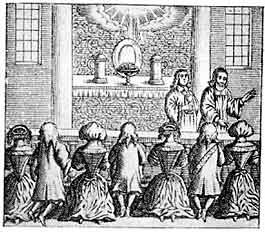'Urged also and affirmed by Origen': Taylor, the Eucharist, and breathing with both lungs
He sees in Origen an understanding of the Eucharist which coheres with that of the English Church - "say we too" - in which heavenly and earthly, spiritual and material realities are affirmed, with the Lord's body "eaten in a spiritual sense", for "this is the plain and natural sense of the words of Origen":
he plainly distinguishes the material part from the spiritual in the sacrament, and affirms, that "according to the material part, that meat that is sanctified by the word of God and prayer, enters into the mouths, descends into the belly, and goes forth in the natural ejection. And this is only true of the typical and symbolical body." Now, besides that it affirms the words of our blessed Saviour to have effect in the sacrament, he affirms, that the material part, the type and symbols, are the body of Christ, that is, his body is present in a typical and symbolical manner. This is the plain and natural sense of the words of Origen ...
But let us see what other words Origen hath, by which we must expound these. Origen says, that "the Christian people drink the blood of Christ, and the flesh of the Word of God is true food." What then? so say we too; but it is spiritual food, and we drink the blood spiritually. He says nothing against that, but very much for it; as I have in several places remarked already ...
When Origen says,' The material part, the symbolical body of Christ, is eaten naturally and cast into the draught,' he means [according to "the Roman opinion"], not the body of Christ in his material part, but the accidents of bread, the colour, the taste, the quantity, these are cast out by the belly ...
This answer cannot be fitted to the words of Origen; for that which he calls the 'quid materiale,' or the material part in the sacrament, he calls it the symbolical body, which cannot be affirmed of accidents, because there is no likeness between the accidents, the colour, the shape, the figure, the roundness, the weight, the magnitude, of the host or wafer, and Christ's body: and therefore, to call the accidents a symbolical body, is to call it an unsymbolical symbol, an unlike similitude, a representment without analogy: but if he means the consecrated bread, the whole action of consecration, distribution, sumption, manducation, this is the symbolical body, according to the words of St. Paul; "He that drinks this cup, and eats this bread, represents the Lord's death;" it is the figure of Christ's crucified body, of his passion and our redemption ...
I conclude, that this argument out of the words of our blessed Saviour, urged also and affirmed by Origen, does prove that Christ's body is in the sacrament, only to be eaten in a spiritual sense, not at all in a natural, lest that consequent be the event of it, which to affirm of Christ's glorified body in the natural and proper sense, were very blasphemy.
Taylor's reliance upon Origen (who, of course, had a profound influence on the Greek Fathers) in this Section, discussing the truth and reality of our spiritual partaking of Christ in the Holy Mysteries, our "spiritual nourishment", is a significant example of the deeply Eastern emphasis throughout this work.




Comments
Post a Comment